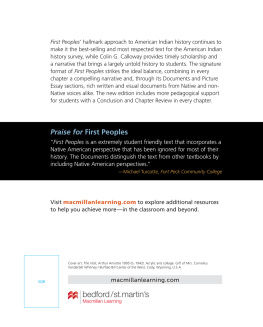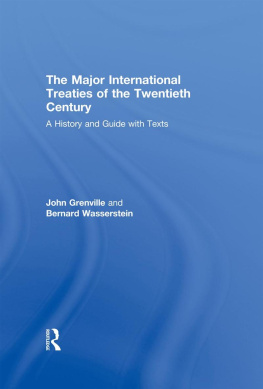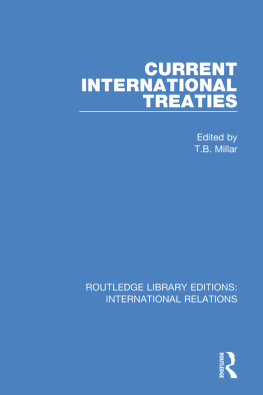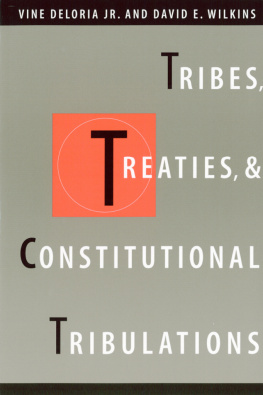Pen and Ink Witchcraft
Pen and Ink Witchcraft
TREATIES AND TREATY MAKING IN AMERICAN INDIAN HISTORY
Colin G. Calloway


Oxford University Press is a department of the University of Oxford. It furthers the Universitys objective of excellence in research, scholarship, and education by publishing worldwide.
Oxford New York
Auckland Cape Town Dar es Salaam Hong Kong Karachi
Kuala Lumpur Madrid Melbourne Mexico City Nairobi
New Delhi Shanghai Taipei Toronto
With offices in
Argentina Austria Brazil Chile Czech Republic France Greece
Guatemala Hungary Italy Japan Poland Portugal Singapore
South Korea Switzerland Thailand Turkey Ukraine Vietnam
Oxford is a registered trademark of Oxford University Press in the UK and certain other countries.
Published in the United States of America by
Oxford University Press
198 Madison Avenue, New York, NY 10016
Oxford University Press 2013
All rights reserved. No part of this publication may be reproduced, stored in a retrieval system, or transmitted, in any form or by any means, without the prior permission in writing of Oxford University Press, or as expressly permitted by law, by license, or under terms agreed with the appropriate reproduction rights organization. Inquiries concerning reproduction outside the scope of the above should be sent to the Rights Department, Oxford University Press, at the address above.
You must not circulate this work in any other form
and you must impose this same condition on any acquirer.
Calloway, Colin G. (Colin Gordon), 1953
Pen and ink witchcraft : treaties and treaty making in American Indian history / Colin G. Calloway.
pages cm
Includes bibliographical references and index.
ISBN 9780199917303 (alk. paper)
1. Indians of North AmericaTreaties. I. Title.
KF8205.C35 2013
346.73013dc23
2012045536
ISBN 9780-199917303
9 8 7 6 5 4 3 2 1
Printed in the United States of America
on acid-free paper
that pen and ink witch-craft, which they can make speak things we
never intended, or had any idea of, even an hundred years hence; just as
they please.the Ottawa chief Egushawa in council on the banks of
the Ottawa River, 1791
Nations that deserve the Title of Treaty breakers, that are not to
be bound by the most solemn Covenants, but break the chain of
Friendship, will soon fall into Contempt.Governor James Glen of
South Carolina to the Six Nations, 1755
To Marcia, Graeme, and Meg
{ CONTENTS }
Anyone doing Indian history has to take account of Indian treaties. I began reading them nearly forty years ago, as a graduate student poring over the manuscript records of innumerable Indian councils in the British Museum and the Public Records Office (now the National Archives) in London. But many scholars have thought about treaties, talked about them, and written about them long before I took on this project. In addition to those whom I have cited in the notes and bibliography, an incomplete list of individuals I remember talking with, listening to, and learning from over the years must include N. Bruce Duthu, the late William N. Fenton and the late Francis Jennings, Laurence M. Hauptman, Frederick E. Hoxie, Francis Paul Prucha, K. Tsianina Lomawaima, Heidi Kiiwetinepinesiik Stark, the late Helen Hornbeck Tanner, Dale Turner, Jace Weaver, and David Wilkins. They and other friends and scholars fueled my interest in Indian treaties at one time or another even if they didnt know it, although they bear no responsibility for this book.
A few had more direct influence. William Campbell and I found ourselves studying the Treaty of Fort Stanwix at about the same time; for Bill it was the core of his dissertationnow his first bookand for me it was a story that had to be told in the book I was envisioning. I am grateful to Bill for sharing his manuscript with me and for reading my chapter on Stanwix. I am indebted to Theda Perdue for reading and commenting on the chapter on New Echota. Not for the first time (and Im sure not for the last) I called on my good friend and colleague Bruce Duthu to cast his expert eye over what I had to say about treaties in modern America. I would not have found Howling Wolfs drawing of the Medicine Lodge treaty council without Joyce M. Szabo, and Sharon Muhlfeld first provided me, many years ago, with the original reference for the pen and ink witchcraft quotation. Ned Blackhawk and a second, anonymous, reviewer carefully read the manuscript for Oxford University Press and provided thoughtful comments and insightful suggestions that helped me to bring out the story more effectively.
In completing the research for this book, I benefited enormously from the assistance of good staff members at the Baker/Berry Library and Rauner Library of Dartmouth College; at the National Archives at College Park, Maryland; and at the Manuscripts and Archives Division of the New York Public Library. For assistance in acquiring illustrations and sometimes other materials, I am grateful to Josh Shaw at Rauner Library; Bridgeman Art Library InternationalNew York; Chicago History Museum; Washington State Historical Society; Library and Archives, Canada; Pennsylvania Historical Society; New-York Historical Society; New York State Library; Oklahoma Historical Society; University of Oklahoma Western History Collections; History Colorado (the Colorado Historical Society); and the National Anthropological Archives and Human Studies Film Archives of the Smithsonian Institution.
As in all my writing and teaching, I use the terms Native American and Indian interchangeably. I also use tribe and nation interchangeably when describing Native American tribal nations, and I do not mean to suggest that they are either less than or the same as nation-states. I recognize that the tribal names that appear in historic records and later histories often reflect other peoples names for the nations in question, not the names the people used to identify themselves, and sometimes not the preferred names today. However, though respectful to the peoples involved, replacing anglicized names with the tribes own names causes other problems. Many readers might recognize Haudenosaunee as a more appropriate term for the Iroquois, and some might recognize Kanienkehaka as Mohawk, but applying this practice consistently to every Indian nation mentioned in the book would confront readers with a bewildering array of unfamiliar terms. For this reason, I suspect, Taiaiake Alfred replaces Mohawk with Kanienkehaka as the appropriate name for his own nation, but he continues to use anglicized names like Sioux, Cheyenne, and Cherokee when referring to other people. Rather than privileging just a few tribes with their own names, I have opted for consistency, using the anglicized names more familiar to most readers, except in cases like Dakota and Lakota, which are not only commonly recognized but also specify particular divisions of the Sioux.
Pen and Ink Witchcraft
In the summer of 1701, 1,300 Indians descended on Montreal, a town with slightly more than one thousand inhabitants. The Indians came from nearly forty separate nations, from as far away as Acadia in the East and the Mississippi in the West. Many of them traveled months to get there. A dozen years earlier, a huge Iroquois war party had destroyed the nearby settlement of La Chine, killing or capturing one hundred people. But the Indians who flocked to Montreal in 1701 came to talk, not to fight.
Next page





![Deloria Jr. - Behind the trail of broken treaties an Indian declaration of independence. [The goundbreaking work by the preeminent spokesperson for American Indian rights]](/uploads/posts/book/171989/thumbs/deloria-jr-behind-the-trail-of-broken-treaties.jpg)

